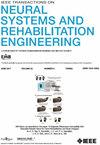具有频率范围、模式和形状的3D刺激对虚拟现实中SSVEP-BCI性能的影响
IF 4.8
2区 医学
Q2 ENGINEERING, BIOMEDICAL
IEEE Transactions on Neural Systems and Rehabilitation Engineering
Pub Date : 2025-02-21
DOI:10.1109/TNSRE.2025.3544308
引用次数: 0
摘要
传统的基于稳态视觉诱发电位(SSVEP)的脑机接口(BCI)系统在激发大脑反应方面具有稳定性和简便性,但其实际应用受到视觉刺激不可移动屏幕的限制。虚拟现实(VR)技术提供了一个更自然和身临其境的环境来唤起SSVEP信号。然而,VR环境中视觉刺激的设计方法仍有待探索,尤其是在立体视觉条件下。本研究探讨了具有频率范围、模式和形状的3D刺激对VR-SSVEP的性能和用户体验的影响。在低频率(9-15Hz)、中频率(18-24Hz)和高频率(30-36Hz)下,有四种模式,包括三维闪烁、二维闪烁、三维棋盘和三维快速响应(QR)码,包括立方体、球体、圆柱体和锥体。通过离线和在线实验分析了不同参数组合对SSVEP-BCI性能的影响,并采用问卷调查的方式评估用户体验。与高频频段相比,低频和中频频段的性能更好,用户体验更差。在所有频率范围内,3D棋盘和3D QR码模式的用户体验都明显好于3D和2D闪烁。3D棋盘格和3D二维码模式在中频范围内具有较高的分类性能,可以综合提升系统性能和用户体验。这些结果对SSVEP-BCI在VR环境中的应用具有重要的参考价值。本文章由计算机程序翻译,如有差异,请以英文原文为准。
Effects of 3D Stimuli With Frequency Ranges, Patterns, and Shapes on SSVEP-BCI Performance in Virtual Reality
Traditional steady-state visual evoked potential (SSVEP) based brain-computer interface (BCI) systems offer stability and simplicity in evoking brain responses, but their practical utility is limited by immovable screens for visual stimuli. Virtual Reality (VR) technology provides a more natural and immersive environment to evoke SSVEP signals. However, the design methods for visual stimuli in VR environments remain to be explored, especially under the stereoscopic vision conditions. This study investigated the effects of 3D stimuli with frequency ranges, patterns, and shapes on the performance and user experiences of VR-SSVEP. There were four patterns including three-dimensional (3D) flicker, two-dimensional (2D) flicker, 3D checkerboard, and 3D quick response (QR) code with four shapes comprising cube, sphere, cylinder, and cone at low (9-15Hz), medium (18-24Hz), and high frequencies (30-36Hz). Both offline and online experiments were conducted to analyze the effects of different parameter combinations on SSVEP-BCI performance, and a questionnaire was exploited to evaluate user experiences. Compared to high frequency range, the low and medium frequency ranges had better performance and lower user experiences. 3D checkerboard and 3D QR code patterns showed significantly better user experiences than 3D and 2D flickers for all frequency ranges. With a high level of classification performance, 3D checkerboard and 3D QR code patterns in medium frequency range could synthetically enhance the system performance and user experiences. These results could provide significant value for SSVEP-BCI application in VR environments.
求助全文
通过发布文献求助,成功后即可免费获取论文全文。
去求助
来源期刊
CiteScore
8.60
自引率
8.20%
发文量
479
审稿时长
6-12 weeks
期刊介绍:
Rehabilitative and neural aspects of biomedical engineering, including functional electrical stimulation, acoustic dynamics, human performance measurement and analysis, nerve stimulation, electromyography, motor control and stimulation; and hardware and software applications for rehabilitation engineering and assistive devices.

 求助内容:
求助内容: 应助结果提醒方式:
应助结果提醒方式:


